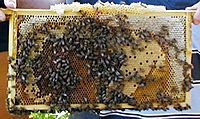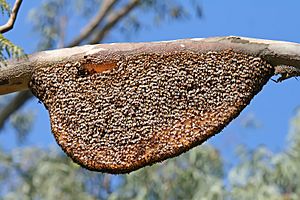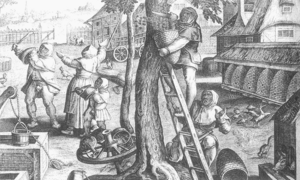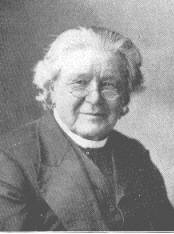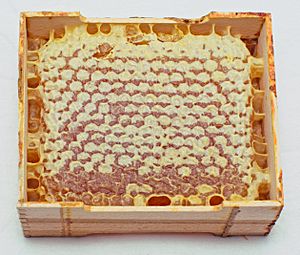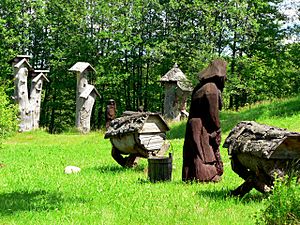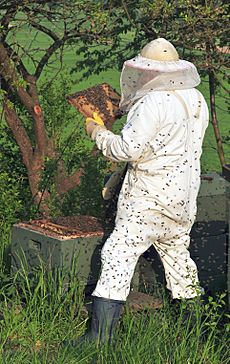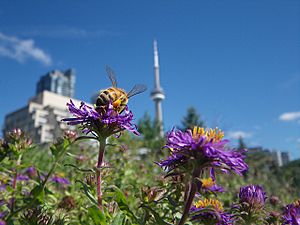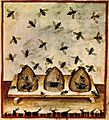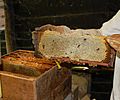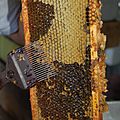Beekeeping facts for kids
Beekeeping or apiculture is the maintenance of honey bee colonies, commonly in man-made hives, by humans. A beekeeper (or apiarist) keeps bees in order to collect their honey and other products that the hive produces (including beeswax, propolis, pollen, and royal jelly), to pollinate crops, or to produce bees for sale to other beekeepers. A location where bees are kept is called an apiary or "bee yard."
Depictions of humans collecting honey from wild bees date to 10,000 years ago. Beekeeping in pottery vessels began about 9,000 years ago in North Africa. Domestication is shown in Egyptian art from around 4,500 years ago. Simple hives and smoke were used and honey was stored in jars, some of which were found in the tombs of pharaohs such as Tutankhamun. It wasn't until the 18th century that European understanding of the colonies and biology of bees allowed the construction of the moveable comb hive so that honey could be harvested without destroying the entire colony.
Contents
Uses
The keeping of bees is usually, and has been in the past, for honey. That is becoming less true. Instead, it is more used for crop pollination and other products. These are wax and propolis.
There is only one queen bee in each hive and she is bigger than the rest. She lays all the eggs, which makes all the other bees in the hive her daughters and sons. However, they do not control the hive.
Types of beekeeping
The largest beekeeping operations are agricultural businesses that are operated for profit. Some people also have small beekeeping operations that they do as a hobby. Urban beekeeping is a growing trend, and some have found that "city bees" are actually healthier than "rural bees" because there are fewer pesticides and greater biodiversity.
History of beekeeping
At some point humans began to attempt to domesticate wild bees in artificial hives made from hollow logs, wooden boxes, pottery vessels, and woven straw baskets or "skeps". Traces of beeswax are found in pot sherds throughout the Middle East beginning about 7000 BCE.
Honeybees were kept in Egypt from antiquity. On the walls of the sun temple of Nyuserre Ini from the Fifth Dynasty, before 2422 BCE, workers are depicted blowing smoke into hives as they are removing honeycombs. Inscriptions detailing the production of honey are found on the tomb of Pabasa from the Twenty-sixth Dynasty (c. 650 BCE), depicting pouring honey in jars and cylindrical hives. Sealed pots of honey were found in the grave goods of pharaohs such as Tutankhamun.
I am Shamash-resh-ușur, the governor of Suhu and the land of Mari. Bees that collect honey, which none of my ancestors had ever seen or brought into the land of Suhu, I brought down from the mountain of the men of Habha, and made them settle in the orchards of the town 'Gabbari-built-it'. They collect honey and wax, and I know how to melt the honey and wax – and the gardeners know too. Whoever comes in the future, may he ask the old men of the town, (who will say) thus: "They are the buildings of Shamash-resh-ușur, the governor of Suhu, who introduced honey bees into the land of Suhu."
— translated text from stele, (Dalley, 2002)
In prehistoric Greece (Crete and Mycenae), there existed a system of high-status apiculture, as can be concluded from the finds of hives, smoking pots, honey extractors and other beekeeping paraphernalia in Knossos. Beekeeping was considered a highly valued industry controlled by beekeeping overseers—owners of gold rings depicting apiculture scenes rather than religious ones as they have been reinterpreted recently, contra Sir Arthur Evans.
Archaeological finds relating to beekeeping have been discovered at Rehov, a Bronze and Iron Age archaeological site in the Jordan Valley, Israel. Thirty intact hives, made of straw and unbaked clay, were discovered by archaeologist Amihai Mazar in the ruins of the city, dating from about 900 BCE. The hives were found in orderly rows, three high, in a manner that could have accommodated around 100 hives, held more than 1 million bees and had a potential annual yield of 500 kilograms of honey and 70 kilograms of beeswax, according to Mazar, and are evidence that an advanced honey industry existed in ancient Israel 3,000 years ago.
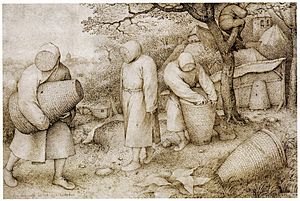
In ancient Greece, aspects of the lives of bees and beekeeping are discussed at length by Aristotle. Beekeeping was also documented by the Roman writers Virgil, Gaius Julius Hyginus, Varro, and Columella.
Beekeeping has also been practiced in ancient China since antiquity. In the book "Golden Rules of Business Success" written by Fan Li (or Tao Zhu Gong) during the Spring and Autumn period there are sections describing the art of beekeeping, stressing the importance of the quality of the wooden box used and how this can affect the quality of the honey.
The ancient Maya domesticated a separate species of stingless bee. The use of stingless bees is referred to as meliponiculture, named after bees of the tribe Meliponini—such as Melipona quadrifasciata in Brazil. This variation of bee keeping still occurs around the world today. For instance, in Australia, the stingless bee Tetragonula carbonaria is kept for production of their honey.
Origins
There are more than 20,000 species of wild bees. Many species are solitary (e.g., mason bees, leafcutter bees (Megachilidae), carpenter bees and other ground-nesting bees). Many others rear their young in burrows and small colonies (e.g., bumblebees and stingless bees). Some honey bees are wild e.g. the little honeybee (Apis florea), giant honeybee (Apis dorsata) and rock bee (Apis laboriosa). Beekeeping, or apiculture, is concerned with the practical management of the social species of honey bees, which live in large colonies of up to 100,000 individuals. In Europe and America the species universally managed by beekeepers is the Western honey bee (Apis mellifera). This species has several sub-species or regional varieties, such as the Italian bee (Apis mellifera ligustica), European dark bee (Apis mellifera mellifera), and the Carniolan honey bee (Apis mellifera carnica). In the tropics, other species of social bees are managed for honey production, including the Asiatic honey bee (Apis cerana).
Wild honey harvesting
Collecting honey from wild bee colonies is one of the most ancient human activities and is still practiced by aboriginal societies in parts of Africa, Asia, Australia, and South America. In Africa, honeyguide birds have evolved a mutualist relationship with humans, leading them to hives and participating in the feast. This suggests honey harvesting by humans may be of great antiquity. Some of the earliest evidence of gathering honey from wild colonies is from rock paintings, dating to around Upper Paleolithic (13,000 BCE). Gathering honey from wild bee colonies is usually done by subduing the bees with smoke and breaking open the tree or rocks where the colony is located, often resulting in the physical destruction of the nest.
Study of honey bees
It was not until the 18th century that European natural philosophers undertook the scientific study of bee colonies and began to understand the complex and hidden world of bee biology. Preeminent among these scientific pioneers were Swammerdam, René Antoine Ferchault de Réaumur, Charles Bonnet, and François Huber. Swammerdam and Réaumur were among the first to use a microscope and dissection to understand the internal biology of honey bees. Réaumur was among the first to construct a glass walled observation hive to better observe activities within hives. He observed queens laying eggs in open cells, but still had no idea of how a queen was fertilized; nobody had ever witnessed the mating of a queen and drone and many theories held that queens were "self-fertile," while others believed that a vapor or "miasma" emanating from the drones fertilized queens without direct physical contact. Huber was the first to prove by observation and experiment that queens are physically inseminated by drones outside the confines of hives, usually a great distance away.
Following Réaumur's design, Huber built improved glass-walled observation hives and sectional hives that could be opened like the leaves of a book. This allowed inspecting individual wax combs and greatly improved direct observation of hive activity. Although he went blind before he was twenty, Huber employed a secretary, François Burnens, to make daily observations, conduct careful experiments, and keep accurate notes over more than twenty years. Huber confirmed that a hive consists of one queen who is the mother of all the female workers and male drones in the colony. He was also the first to confirm that mating with drones takes place outside of hives and that queens are inseminated by a number of successive matings with male drones, high in the air at a great distance from their hive. Together, he and Burnens dissected bees under the microscope and were among the first to describe the ovaries and spermatheca, or sperm store, of queens as well as the penis of male drones. Huber is universally regarded as "the father of modern bee-science" and his "Nouvelles Observations sur Les Abeilles (or "New Observations on Bees") revealed all the basic scientific truths for the biology and ecology of honeybees.
Invention of the movable comb hive
Early forms of honey collecting entailed the destruction of the entire colony when the honey was harvested. The wild hive was crudely broken into, using smoke to suppress the bees, the honeycombs were torn out and smashed up — along with the eggs, larvae and honey they contained. The liquid honey from the destroyed brood nest was strained through a sieve or basket. This was destructive and unhygienic, but for hunter-gatherer societies this did not matter, since the honey was generally consumed immediately and there were always more wild colonies to exploit. But in settled societies the destruction of the bee colony meant the loss of a valuable resource; this drawback made beekeeping both inefficient and something of a "stop and start" activity. There could be no continuity of production and no possibility of selective breeding, since each bee colony was destroyed at harvest time, along with its precious queen.
During the medieval period abbeys and monasteries were centers of beekeeping, since beeswax was highly prized for candles and fermented honey was used to make alcoholic mead in areas of Europe where vines would not grow. The 18th and 19th centuries saw successive stages of a revolution in beekeeping, which allowed the bees themselves to be preserved when taking the harvest.
Intermediate stages in the transition from the old beekeeping to the new were recorded for example by Thomas Wildman in 1768/1770, who described advances over the destructive old skep-based beekeeping so that the bees no longer had to be killed to harvest the honey. Wildman for example fixed a parallel array of wooden bars across the top of a straw hive or skep (with a separate straw top to be fixed on later) "so that there are in all seven bars of deal" [in a 10-inch-diameter (250 mm) hive] "to which the bees fix their combs." He also described using such hives in a multi-storey configuration, foreshadowing the modern use of supers: he described adding (at a proper time) successive straw hives below, and eventually removing the ones above when free of brood and filled with honey, so that the bees could be separately preserved at the harvest for a following season. Wildman also described a further development, using hives with "sliding frames" for the bees to build their comb, foreshadowing more modern uses of movable-comb hives. Wildman's book acknowledged the advances in knowledge of bees previously made by Swammerdam, Maraldi, and de Réaumur—he included a lengthy translation of Réaumur's account of the natural history of bees—and he also described the initiatives of others in designing hives for the preservation of bee-life when taking the harvest, citing in particular reports from Brittany dating from the 1750s, due to Comte de la Bourdonnaye. However, the forerunners of the modern hives with movable frames that are mainly used today are considered the traditional basket top bar (movable comb) hives of Greece, known as “Greek beehives”. The oldest testimony on their use dates back to 1669 although it is probable that their use is more than 3000 years old.
The 19th century saw this revolution in beekeeping practice completed through the perfection of the movable comb hive by the American Lorenzo Lorraine Langstroth. Langstroth was the first person to make practical use of Huber's earlier discovery that there was a specific spatial measurement between the wax combs, later called the bee space, which bees do not block with wax, but keep as a free passage. Having determined this bee space (between 5 and 8 mm, or 1/4 to 3/8"), Langstroth then designed a series of wooden frames within a rectangular hive box, carefully maintaining the correct space between successive frames, and found that the bees would build parallel honeycombs in the box without bonding them to each other or to the hive walls. This enables the beekeeper to slide any frame out of the hive for inspection, without harming the bees or the comb, protecting the eggs, larvae and pupae contained within the cells. It also meant that combs containing honey could be gently removed and the honey extracted without destroying the comb. The emptied honey combs could then be returned to the bees intact for refilling. Langstroth's book, The Hive and Honey-bee, published in 1853, described his rediscovery of the bee space and the development of his patent movable comb hive.
The invention and development of the movable-comb-hive fostered the growth of commercial honey production on a large scale in both Europe and the USA (see also Beekeeping in the United States).
Evolution of hive designs
Langstroth's design for movable comb hives was seized upon by apiarists and inventors on both sides of the Atlantic and a wide range of moveable comb hives were designed and perfected in England, France, Germany and the United States. Classic designs evolved in each country: Dadant hives and Langstroth hives are still dominant in the USA; in France the De-Layens trough-hive became popular and in the UK a British National hive became standard as late as the 1930s although in Scotland the smaller Smith hive is still popular. In some Scandinavian countries and in Russia the traditional trough hive persisted until late in the 20th century and is still kept in some areas. However, the Langstroth and Dadant designs remain ubiquitous in the USA and also in many parts of Europe, though Sweden, Denmark, Germany, France and Italy all have their own national hive designs. Regional variations of hive evolved to reflect the climate, floral productivity and the reproductive characteristics of the various subspecies of native honey bee in each bio-region.
The differences in hive dimensions are insignificant in comparison to the common factors in all these hives: they are all square or rectangular; they all use movable wooden frames; they all consist of a floor, brood-box, honey super, crown-board and roof. Hives have traditionally been constructed of cedar, pine, or cypress wood, but in recent years hives made from injection molded dense polystyrene have become increasingly important.
Hives also use queen excluders between the brood-box and honey supers to keep the queen from laying eggs in cells next to those containing honey intended for consumption. Also, with the advent in the 20th century of mite pests, hive floors are often replaced for part of (or the whole) year with a wire mesh and removable tray.
Traditional beekeeping
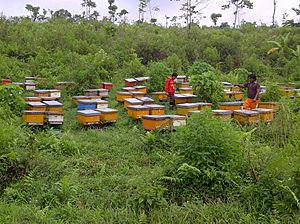
Fixed comb hives
A fixed comb hive is a hive in which the combs cannot be removed or manipulated for management or harvesting without permanently damaging the comb. Almost any hollow structure can be used for this purpose, such as a log gum, skep, wooden box, or a clay pot or tube. Fixed comb hives are no longer in common use in industrialized countries, and are illegal in places that require movable combs to inspect for problems such as varroa and American foulbrood. In many developing countries fixed comb hives are widely used and, because they can be made from any locally available material, are very inexpensive.
Beekeeping using fixed comb hives is an essential part of the livelihoods of many communities in poor countries. The charity Bees for Development recognizes that local skills to manage bees in fixed comb hives are widespread in Africa, Asia, and South America. Internal size of fixed comb hives range from 32.7 liters (2000 cubic inches) typical of the clay tube hives used in Egypt to 282 liters (17209 cubic inches) for the Perone hive. Straw skeps, bee gums, and unframed box hives are unlawful in most US states, as the comb and brood cannot be inspected for diseases. However, skeps are still used for collecting swarms by hobbyists in the UK, before moving them into standard hives. Quinby used box hives to produce so much honey that he saturated the New York market in the 1860s. His writings contain excellent advice for management of bees in fixed comb hives.
Modern beekeeping
Top-bar hives
Top bar hives have been widely adopted in Africa where they are used to keep tropical honeybee ecotypes. Their advantages include being light weight, adaptable, easy to harvest honey, and less stressful for the bees. Disadvantages include combs that are fragile and cannot usually be extracted and returned to the bees to be refilled and that they cannot easily be expanded for additional honey storage.
A growing number of amateur beekeepers are adopting various top-bar hives similar to the type commonly found in Africa. Top bar hives were originally used as a traditional beekeeping method in Greece and Vietnam with a history dating back over 2000 years. These hives have no frames and the honey-filled comb is not returned after extraction. Because of this, the production of honey is likely to be somewhat less than that of a frame and super based hive such as Langstroth or Dadant. Top bar hives are mostly kept by people who are more interested in having bees in their garden than in honey production per se. Some of the most well known top-bar hive designs are the Kenyan Top Bar Hive with sloping sides, the Tanzanian Top Bar Hive with straight sides, and Vertical Top Bar Hives, such as the Warre or "People's Hive" designed by Abbe Warre in the mid-1900s.
The initial costs and equipment requirements are typically much less than other hive designs. Scrap wood or #2 or #3 pine can often be used to build a nice hive. Top-bar hives also offer some advantages to interacting with the bees and the amount of weight that must be lifted is greatly reduced. Top-bar hives are being widely used in developing countries in Africa and Asia as a result of the Bees for Development program. Since 2011, a growing number of beekeepers in the U.S. are using various top-bar hives.
Horizontal frame hives
The De-Layens hive, Jackson Horizontal Hive, and various chest type hives are widely used in Spain, France, Ukraine, Belarus, Africa, and parts of Russia. They are a step up from fixed comb and top bar hives because they have movable frames that can be extracted. Their limitation is primarily that volume is fixed and not easily expanded. Honey has to be removed one frame at a time, extracted or crushed, and the empty frames returned to be refilled. Various horizontal hives have been adapted and widely used for commercial migratory beekeeping. The Jackson Horizontal Hive is particularly well adapted for tropical agriculture. The De-Layens hive is popular in parts of Spain.
Vertical stackable frame hives
In the United States, the Langstroth hive is commonly used. The Langstroth was the first successful top-opened hive with movable frames. Many other hive designs are based on the principle of bee space first described by Langstroth. The Langstroth hive is a descendant of Jan Dzierzon’s Polish hive designs. In the United Kingdom, the most common type of hive is the British National, which can hold Hoffman, British Standard or Manley frames. It is not unusual to see some other sorts of hive (Smith, Commercial, WBC, Langstroth, and Rose). Dadant and Modified Dadant hives are widely used in France and Italy where their large size is an advantage. Square Dadant hives – often called 12 frame Dadant or Brother Adam hives – are used in large parts of Germany and other parts of Europe by commercial beekeepers. The Rose hive is a modern design that attempts to address many of the flaws and limitations of other movable frame hives. The only significant weakness of the Rose design is that it requires 2 or 3 boxes as a brood nest which infers a large number of frames to be worked when managing the bees. The major advantage shared by these designs is that additional brood and honey storage space can be added via boxes of frames added to the hive. This also simplifies honey collection since an entire box of honey can be removed instead of removing one frame at a time.
Protective clothing
Most beekeepers also wear some protective clothing. Novice beekeepers usually wear gloves and a hooded suit or hat and veil. Experienced beekeepers sometimes elect not to use gloves because they inhibit delicate manipulations. The face and neck are the most important areas to protect, so most beekeepers wear at least a veil. Defensive bees are attracted to the breath, and a sting on the face can lead to much more pain and swelling than a sting elsewhere, while a sting on a bare hand can usually be quickly removed by fingernail scrape to reduce the amount of venom injected.
The protective clothing is generally light colored (but not colorful) and of a smooth material. This provides the maximum differentiation from the colony's natural predators (such as bears and skunks) which tend to be dark-colored and furry.
'Stings' retained in clothing fabric continue to pump out an alarm pheromone that attracts aggressive action and further stinging attacks. Washing suits regularly, and rinsing gloved hands in vinegar minimizes attraction.
Smoker
Smoke is the beekeeper's third line of defense. Most beekeepers use a "smoker"—a device designed to generate smoke from the incomplete combustion of various fuels. Smoke calms bees; it initiates a feeding response in anticipation of possible hive abandonment due to fire. Smoke also masks alarm pheromones released by guard bees or when bees are squashed in an inspection. The ensuing confusion creates an opportunity for the beekeeper to open the hive and work without triggering a defensive reaction. In addition, when a bee consumes honey the bee's abdomen distends, supposedly making it difficult to make the necessary flexes to sting, though this has not been tested scientifically.
Smoke is of questionable use with a swarm, because swarms do not have honey stores to feed on in response. Usually smoke is not needed, since swarms tend to be less defensive, as they have no stores or brood to defend, and a fresh swarm has fed well from the hive.
Many types of fuel can be used in a smoker as long as it is natural and not contaminated with harmful substances. These fuels include hessian, twine, burlap, pine needles, corrugated cardboard, and mostly rotten or punky wood. Indian beekeepers, especially in Kerala, often use coconut fibers as they are readily available, safe, and of negligible expense. Some beekeeping supply sources also sell commercial fuels like pulped paper and compressed cotton, or even aerosol cans of smoke. Other beekeepers use sumac as fuel because it ejects lots of smoke and doesn't have an odor.
Some beekeepers are using "liquid smoke" as a safer, more convenient alternative. It is a water-based solution that is sprayed onto the bees from a plastic spray bottle.
Torpor may also be induced by the introduction of chilled air into the hive – while chilled carbon dioxide may have harmful long-term effects.
Effects of stings and of protective measures
Some beekeepers believe that the more stings a beekeeper receives, the less irritation each causes, and they consider it important for safety of the beekeeper to be stung a few times a season. Beekeepers have high levels of antibodies (mainly IgG) reacting to the major antigen of bee venom, phospholipase A2 (PLA). Antibodies correlate with the frequency of bee stings.
The entry of venom into the body from bee-stings may also be hindered and reduced by protective clothing that allows the wearer to remove stings and venom sacs with a simple tug on the clothing. Although the stinger is barbed, a worker bee is less likely to become lodged into clothing than human skin.
If a beekeeper is stung by a bee, there are many protective measures that should be taken in order to make sure the affected area does not become too irritated. The first cautionary step that should be taken following a bee sting is removing the stinger without squeezing the attached venom glands. A quick scrape with a fingernail is effective and intuitive. This step is effective in making sure that the venom injected does not spread, so the side effects of the sting will go away sooner. Washing the affected area with soap and water is also a good way to stop the spread of venom. The last step that needs to be taken is to apply ice or a cold compress to the stung area.
Natural beekeeping
The natural beekeeping movement believes that modern beekeeping and agricultural practices, such as crop spraying, hive movement, frequent hive inspections, artificial insemination of queens, routine medication, and sugar water feeding, weaken bee hives.
Practitioners of "natural beekeeping" tend to use variations of the top-bar hive, which is a simple design that retains the concept of movable comb without the use of frames or foundation. The horizontal top-bar hive, as championed by Marty Hardison, Michael Bush, Philip Chandler, Dennis Murrell and others, can be seen as a modernization of hollow log hives, with the addition of wooden bars of specific width from which bees hang their combs. Its widespread adoption in recent years can be attributed to the publication in 2007 of The Barefoot Beekeeper by Philip Chandler, which challenged many aspects of modern beekeeping and offered the horizontal top-bar hive as a viable alternative to the ubiquitous Langstroth-style movable-frame hive.
The most popular vertical top-bar hive is probably the Warré hive, based on a design by the French priest Abbé Émile Warré (1867–1951) and popularized by Dr. David Heaf in his English translation of Warré's book L'Apiculture pour Tous as Beekeeping For All.
Urban or backyard beekeeping
Related to natural beekeeping, urban beekeeping is an attempt to revert to a less industrialized way of obtaining honey by utilizing small-scale colonies that pollinate urban gardens. Urban apiculture has undergone a renaissance in the first decade of the 21st century, and urban beekeeping is seen by many as a growing trend.
Some have found that "city bees" are actually healthier than "rural bees" because there are fewer pesticides and greater biodiversity. Urban bees may fail to find forage, however, and homeowners can use their landscapes to help feed local bee populations by planting flowers that provide nectar and pollen. An environment of year-round, uninterrupted bloom creates an ideal environment for colony reproduction.
Indoor beekeeping
Modern beekeepers have experimented with raising bees indoors, in a controlled environment or in indoor observation hives. This may be done for reasons of space and monitoring, or in the off-season. In the off-season, large commercial beekeepers may move colonies to "wintering" warehouses, with fixed temperature, light and humidity. This helps the bees remain healthy, but relatively dormant. Wintered bees survive on stored honey, and new bees are not born.
Experiments in raising bees for longer durations indoors have looked into more detailed and varying environment controls. In 2015, MIT's Synthetic Apiary project simulated springtime inside a closed environment, for a number of hives over the course of a winter. They provided food sources and simulated long days, and saw activity and reproduction levels comparable to that seen outdoors in warm weather. They concluded that such an indoor apiary could be sustained year-round if needed.
Images for kids
-
Beekeeping, tacuinum sanitatis casanatensis (14th century)
See also
 In Spanish: Apicultura para niños
In Spanish: Apicultura para niños


